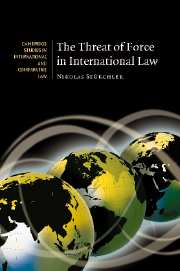Book contents
- Frontmatter
- Contents
- Foreword
- Preface
- List of abbreviations
- 1 Birth and infancy of a Charter rule: the open framework
- 2 The menu of choice: a guide to interpretation
- 3 Precedents of the international court of justice
- 4 Deciphering post-Charter practice: means and limits
- 5 Open threats to extract concessions
- 6 Demonstrations of force
- 7 Countervailing threats or: threats in self-defence
- 8 Findings and conclusions
- 9 Epilogue: the law in operation
- Annex
- Bibliography
- Index
- CAMBRIDGE STUDIES IN INTERNATIONAL AND COMPARATIVE LAW
1 - Birth and infancy of a Charter rule: the open framework
Published online by Cambridge University Press: 04 July 2009
- Frontmatter
- Contents
- Foreword
- Preface
- List of abbreviations
- 1 Birth and infancy of a Charter rule: the open framework
- 2 The menu of choice: a guide to interpretation
- 3 Precedents of the international court of justice
- 4 Deciphering post-Charter practice: means and limits
- 5 Open threats to extract concessions
- 6 Demonstrations of force
- 7 Countervailing threats or: threats in self-defence
- 8 Findings and conclusions
- 9 Epilogue: the law in operation
- Annex
- Bibliography
- Index
- CAMBRIDGE STUDIES IN INTERNATIONAL AND COMPARATIVE LAW
Summary
My dear Briand, I have been reading this wonderful book … Vom Kriege [by] Karl von Clausewitz … I came upon an extraordinary chapter … entitled ‘War as an Instrument of Policy.’ Why has not the time come for the civilized governments of the world formally to renounce war as an instrument of policy?
Nicholas Murray Butler to Aristide Briand (June 1926), describing the origins of the Kellog-Briand PactArticle 2(4)'s blind spot
After sixty years of United Nations (UN) activity, there seems little of a peg on which to hang yet another investigation into the regime of force. The UN Charter law regulating the initiation of interstate military action has been examined innumerable times. Its main pillars, article 2(4), article 51 and chapter VII, are well known. The outlawing of force as the first pillar is one of the key dictates of international law:
All Members shall refrain in their international relations from the threat or use of force against the territorial integrity or political independence of any state, or in any other manner inconsistent with the Purposes of the United Nations.
Surprisingly, however, even the most comprehensive discussions of the force regime have turned a blind eye to one of its components: the prohibition of military threats. Article 2(4) expressly forbids ‘the threat or use of force’. Yet what is to be understood by the first part of that phrase, and how the UN and individual states have treated it, has until now remained entirely unexplored.
- Type
- Chapter
- Information
- The Threat of Force in International Law , pp. 1 - 36Publisher: Cambridge University PressPrint publication year: 2007

